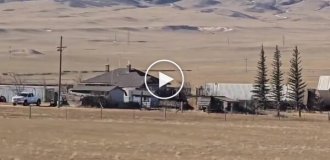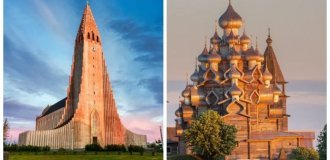The most luxurious palace in the Moscow region (17 photos)
The head of Gazprom is building himself a luxurious palace in the style of the 18th century worth $50 million. Design documentation for the proposed future residence of the head of Gazprom Alexey Miller, which looks like a huge palace in the style of the 18th century. An impressive palace, very similar to the mansion in Peterhof, that suddenly grew up on the banks of the Istra Reservoir initially caused a lot of noise in blogs. But officially, the head of Gazprom, Alexey Miller, who was listed as the real owner of the palace, did not admit that he had anything to do with it. “Our company has nothing to do with the Istra Estate,” said Gazprom press secretary Sergei Kupriyanov. But at the same time, Miller categorically refused to comment on the ownership of the mansion, that is, he neither confirmed nor denied it. The trick is that this palace used to be on the Google map, but now it’s not there, see the photos at the end. One can only guess how serious this person is that even Google is hiding this palace.

All residents of the village of Berezhki who agree to talk about the estate are sure that it is Miller’s palace. There are basically no other versions.

“This is definitely Miller’s palace. He even came here three or four times,” says Sergei, a Berezhkovka resident. Minority shareholder of Gazprom Alexey Navalny and former State Duma deputy, leader of the Moscow region branch of the Right Cause party Boris Nadezhdin confirmed that Miller owns the palace, citing their sources.

In the village of Berezhki, the palace and park ensemble is visible from everywhere. The main house, as it appears in the project documentation, flaunts in the very center of a gigantic plot of 31 hectares. The blue pseudo-baroque building is decorated with white vases along the perimeter of the roof. Most of the territory is surrounded by a high concrete fence. On the water side, the fence is mesh, and other buildings are clearly visible. An artificial canal (there is no water in it yet) leads from the palace to the pavilion; along it, on both sides, there is a French-style park with future fountains. There is also a garage and a turret with a weather vane of unclear purpose.

The administration of the rural settlement of Sokolovskoye, to which Berezhki belongs, claims that construction has been going on for about five years. The territory of 31.9 hectares (according to the Federal Real Estate Cadastre Agency) was purchased from local residents, who, as a result of privatization in the 90s, were given 1.5 hectares of land. On November 5, 2003, the government of the Moscow region changed the purpose of the site from “agricultural land” to “settlement land” (Resolution No. 642/40), which allowed construction to begin on it. According to the head of the administration, Marina Veremeenko, there are no complaints about the construction from local residents. “Once upon a time, we went to the site to check because of complaints about garbage, but since then everything has been fine,” Veremeenko said. Residents of Berezhki, indeed, say that they have nothing against the construction of the local Peterhof (the palace is very reminiscent of it), “the main thing is that the river is not spoiled.”

Local resident Alexey says that several years ago he worked at a construction site and was paid very well there. “At first there were 600 workers here, but now there are about 300,” he says. Next to the palace, behind the same fence, the Istra Estate cottage community is being built. The customer of the project, as the sign says, is the company Stroygazconsulting, and the general contractor is CJSC Delor. Both the palace and the cottages are guarded by the same private security company, Stone. One of the security guards, escorting the Gazeta.Ru correspondent away from the construction site, says that he is guarding an object of national importance, but refuses to say what it is and who it belongs to. No more than six cottages and a church are being built in the village. Delors, where the correspondent called, does not deny the fact of construction, but refuses further comments. Locals are sure that “Miller’s friends” will live in the cottages around. Across the road, also behind a massive fence, are several more technical buildings and trailers for workers.

Stroygazconsulting is a large company (it employs almost 30 thousand people), specializing in infrastructure projects for Gazprom, in particular, it is engaged in the construction of gas pipelines (Nord Stream and others). The president of the company is Ziyad Manasir, who in the latest list of the richest businessmen of the Russian version of Forbes magazine occupies 75th position with a fortune of $500 million. The magazine calls Manasir a person from Putin’s entourage. The co-owner of Stroygazconsulting is Olga Grigorieva, the daughter of ex-deputy director of the FSB and Putin’s friend Alexander Grigoriev (former head of the State Reserve, who died suddenly in December last year). The company that Gazeta.Ru contacted honestly admitted that they were building a “baroque palace,” but for their own purposes. “We are building a palace in the style of the 18th century for ourselves. It is not a copy of Peterhof; rather, it was taken from all known palaces. We have money and we decided to spend it this way. Most likely, we will hold receptions here and receive delegations,” Victoria Mironova, head of the public relations department, told Gazeta.Ru. According to her, the palace has nothing to do with Miller personally or with Gazprom as a whole. Why a rather highly specialized contractor would need a gigantic reception house remains a mystery.

The author of the project for the improvement and landscaping of the Istra Estate Park is the Bruns-Park company. Gazprom is in first place on the list of its clients. The company confirmed that they developed a project for the park in 2006–2007, and it was accepted, but refused to name the customer. It is interesting that Mironova knows nothing about the construction of a cottage village. According to her, Stroygazconsulting is building only a palace on the shore of the Istrinsky reservoir. At the same time, the Stroygazconsulting department responsible for this particular project confirmed the fact of construction, stating that “the cottages are not for sale, since they already have owners.” Gazeta.Ru managed to obtain a project for the construction of the Istrinskaya Usadba cottage village, the customer of which is Stroygazconsulting. The village project was approved on December 12, 2006 at a meeting of the urban planning commission of the Moscow regional government. The village was divided into three sections, the total area of which was more than 37 hectares (5.8 hectares of which are occupied by communications), of which the development occupies about 9 thousand square meters. m. In total, on the territory of the cottage village there should have been 26 buildings, of which 6 were residential buildings. According to the agreed project, only 25 people were supposed to live in the village.

However, on October 23, 2008, the urban planning commission again reviewed and approved a slightly modified project for the Istrinskaya Estate. The area remained the same, but the number of residential buildings increased and amounted to 11. There are just five houses on the territory of the palace and park ensemble. Unlike the cottages still under construction, the palace and other buildings of the ensemble have already been completed. The deputy head of the Solnechnogorsk district administration, Vladimir Zaitsev, who gave permission for the advanced construction of these five houses on the territory of the village, in a conversation with Gazeta.Ru, could not remember either the palace or the park, although he recalled the project of the Stroygazconsulting company. “We haven’t heard anything from them lately,” Zaitsev said. The approximate cost of the Istra Estate, as calculated by Gazeta.Ru with the help of real estate specialists, is $50 million, even taking into account the decline in the market.

The general director of the Analytical Group of G. M. Sternik, Sergei Sternik, estimated the cost of 31.9 hectares at almost $16 million ($5 thousand per hundred square meters). The cost of the development, which the expert compared to a good country hotel, was estimated at $3 thousand per square meter, i.e. only $27 million. The cost is seriously increased by complex hydraulic structures that will make up a cascade of fountains, as well as the creation of a landscape park. Exclusive finishing work “a la Peterhof” may cause an additional increase in price. According to Mironova from Stroygazconsulting, “the palace costs no more than a standard panel house.” Gazprom's minority shareholder Navalny is confident that Gazprom can even hide a skyscraper under another legal entity. “It may have been built for him, but in fact it was registered in the name of another person or company. There’s no way you can undermine it legally,” Navalny said.





























